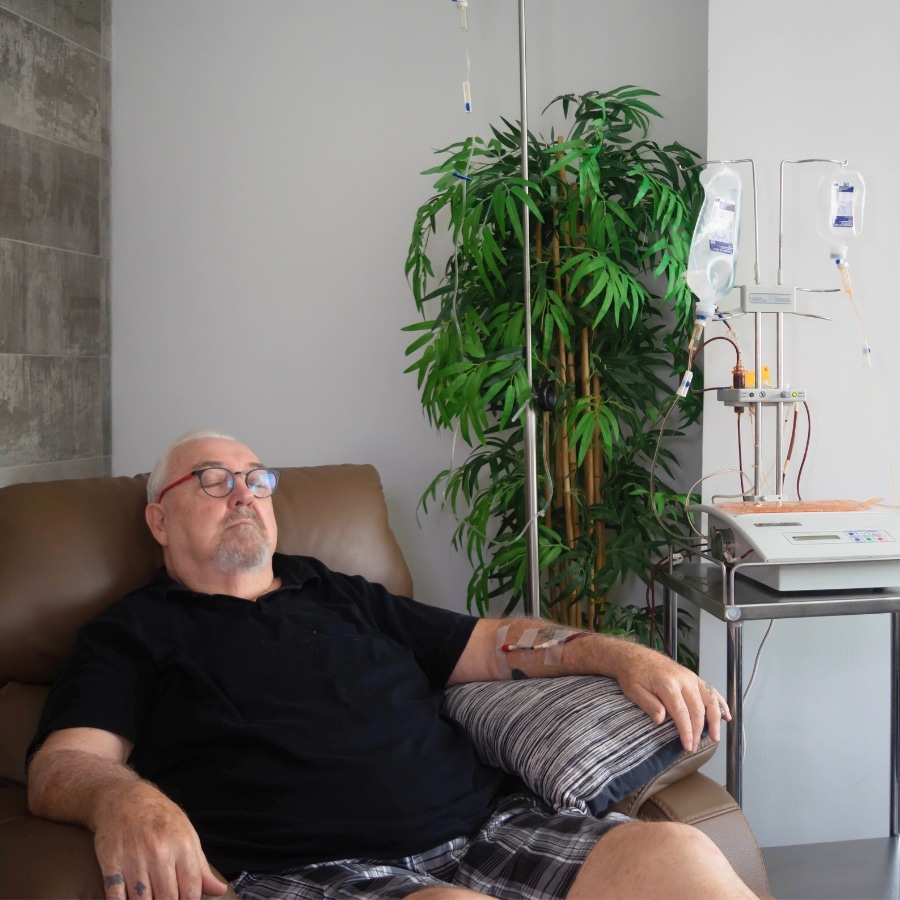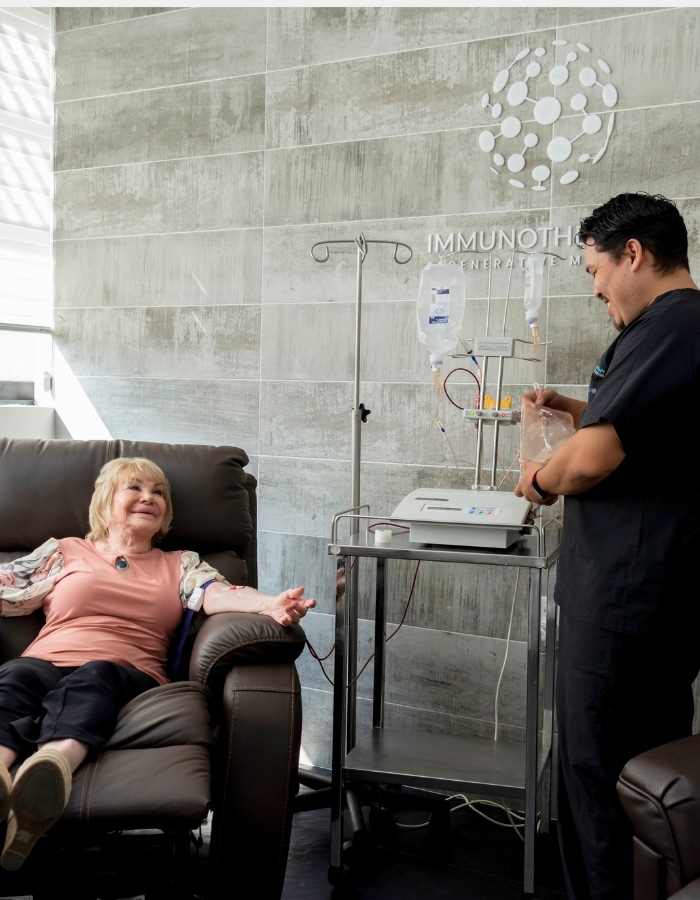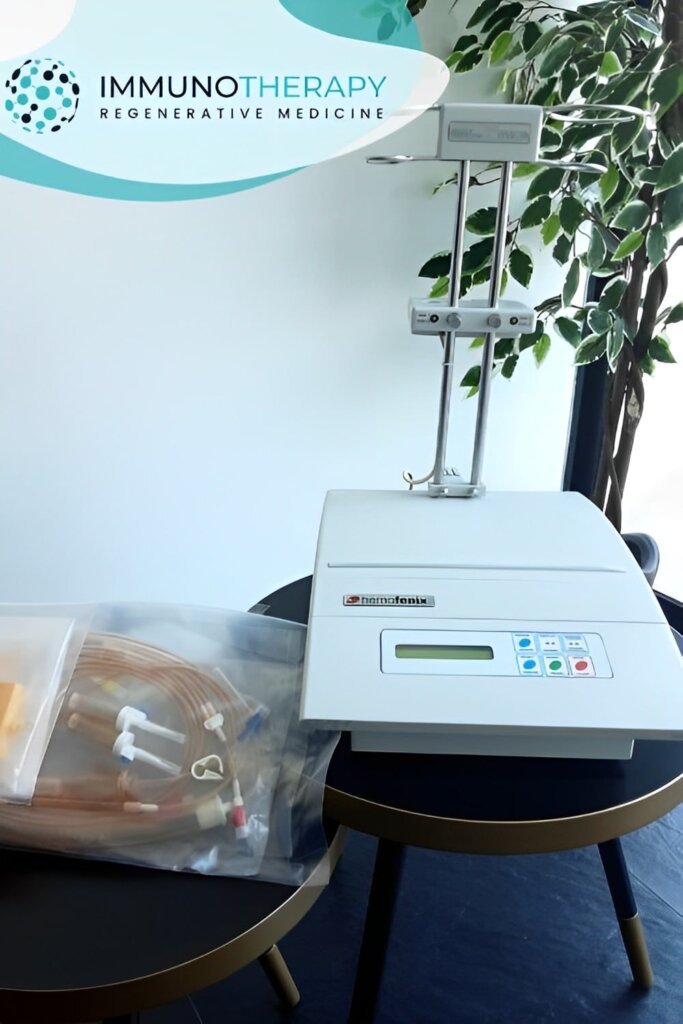Plasmapheresis by Nanomembrane Technology
Experience safe, comfortable, and painless blood cleansing
Having trouble playing this video? Watch it on YouTube
Plasmapheresis Treatment
Promote natural healing
When you’re sick from disease, your blood’s plasma may contain antibodies that attack the immune system and prevent it from protecting your body properly. If this is the case, then plasmapheresis treatment may help.
Plasmapheresis helps cleanse your blood using a low-cost and quick therapeutic option. It’s a safe and comfortable procedure.
The plasma, the liquid part of your blood, is separated from the rest of the blood and treated or replaced before going back into circulation. Plasmapheresis acts almost like a blood “purification” process to aid in your healing.
There are elements in the blood that can’t be easily excreted (pathological immune complexes, heavy metals, excess lipids, etc.), even if our kidneys and liver are healthy. These elements may affect micro-circulation, metabolism and adequate organ function, deriving in an alteration of our regeneration system.
What is plasmapheresis?
Plasmapheresis is a medical procedure that separates the plasma, the liquid component of your blood, from potentially harmful molecules for therapeutic purposes. This treatment acts almost like a purification process for your blood. When certain diseases are present, your plasma can contain antibodies that mistakenly attack your own immune system, hindering its ability to protect your body effectively. In such situations, plasmapheresis can serve as an efficient solution due to its relatively short treatment time and affordability.
Utilizing nanofiltration technology, plasmapheresis enables the extraction of pathological immune complexes, heavy metals, excess lipids, and other substances or molecules that the body struggles to eliminate naturally. Untreated, these substances can trigger diseases or inflammatory processes.

What diseases are treated with plasmapheresis or plasma exchange?
Plasmapheresis, as part of a comprehensive treatment, can be used in the management of various diseases, including:
- Guillain-Barré Syndrome
- Autoimmune disorders
- Chronic-degenerative diseases
- Neurological disorders
- Systemic Lupus Erythematosus
- Myasthenia Gravis
- Idiopathic Thrombocytopenic Purpura
- Acute Multiple Sclerosis
- Autoimmune Encephalitis
- Alzheimer’s Disease
- Movement Disorders (e.g., dyskinesias, dystonia)
- Intoxications from drugs, chemicals, or poisons
- Goodpasture’s Syndrome (glomerulonephritis and lung disease)
- Systemic Vasculitis (e.g., Wegener’s Granulomatosis, Polyarteritis Nodosa)
- Multifocal Motor Neuropathy
- Lambert-Eaton Syndrome
- Paroxysmal Nocturnal Hemoglobinuria
- Organ Transplants (pre and post-transplant)
- Cancer
What are the benefits of plasmapheresis?
Normalization of Cholesterol and Glucose
Plasmapheresis is a highly effective procedure that can significantly reduce levels of total cholesterol, triglycerides, HDL, LDL, and glucose in patients, returning them to normal ranges.
Removal of harmful molecules
Plasmapheresis is effective in removing harmful molecules from the blood, such as autoantibodies, immune complexes, and toxins. This removal can help reduce inflammation, prevent further tissue damage, and improve the patient’s condition.
Reduction in Inflammatory Mediators
Plasmapheresis helps in the removal of certain inflammatory mediators, such as cytokines, from the bloodstream. This can lead to a reduction in systemic inflammation, aiding in the relief of symptoms and improvement of overall health.
Improvement of organ function
In certain autoimmune diseases and neurological disorders, plasmapheresis can help improve organ function. By removing the antibodies that are attacking the body’s organs and tissues, plasmapheresis can stop or slow down damage to the affected organ, allowing it to function better.
Increase in energy and physical performance
Plasmapheresis can help you feel more energetic and improve your physical performance by removing harmful substances and reducing the burden on your immune system.
Complementary to other treatments
Plasmapheresis can be used in conjunction with other therapies, such as immunosuppressive drugs, to enhance the effectiveness of treatment.

Plasmapheresis for Anti-aging
Feel and look younger
Most grown adults accumulate pathological products in their body which may lead to premature aging, with signs showing both inside and out. This accumulation can’t pass through the kidneys, be destroyed by the liver, or be removed using drugs.
A solution for stopping the vicious cycle of this accumulation in the blood, which affects the entire body, is plasmapheresis. Plasmapheresis works to increase immune system efficiency and, in turn, improve the quality of life for middle-aged and older patients.
Instead of waiting for age-related ailments or changes in appearance, we recommend preventing aging with plasmapheresis. Our plasma exchange procedures help promote graceful aging for better function and beauty.

Frequently Asked Questions - Plasmapheresis
If you have any questions or need to consult something, please call +1 800 218-2858.
How does plasmapheresis work?
The plasmapheresis allows the pumping of the blood, which then goes through a nano-membrane filter, which captures the unnecessary elements and throws them out, the blood is then returned to the body, now free of those harming elements.
How long does plasmapheresis take?
The duration of plasmapheresis treatment can vary depending on the patient’s status and the specific condition being treated. However, a typical plasmapheresis session can last from 2 to 4 hours.
Is plasmapheresis painful?
Plasmapheresis itself should not be painful. However, patients may experience some discomfort at the site of needle insertion. Some patients may also experience side effects such as muscle cramps or a feeling of cold during or after the procedure.
Plasmapheresis vs plasma exchange, what's the difference?
Plasmapheresis and plasma exchange are terms that are often used interchangeably. Both refer to the removal, treatment, and reintroduction of plasma into the patient’s body. However, in some contexts, plasmapheresis may refer to the simple extraction of plasma without returning it, while plasma exchange always involves returning the treated plasma or a plasma substitute to the body.
Is plasmapheresis the same as dialysis?
Although both are blood filtering techniques, plasmapheresis and dialysis are not the same. Plasmapheresis is used to remove specific substances from blood plasma, while dialysis is used to filter waste and excess water from the blood when the kidneys are not functioning properly.
How long is the recovery period after plasmapheresis?
Recovery after plasmapheresis can vary from one patient to another. Some people may feel tired or weak after the procedure and may need to rest for the remainder of the day. Others may be able to resume their normal activities immediately.
Can plasmapheresis be combined with other treatments?
Yes, plasmapheresis can be used in combination with other treatments, such as immunosuppressive drugs, to increase the effectiveness of the treatment. The decision to use plasmapheresis in combination with other treatments will depend on the specific condition being treated and the patient’s response to treatment.